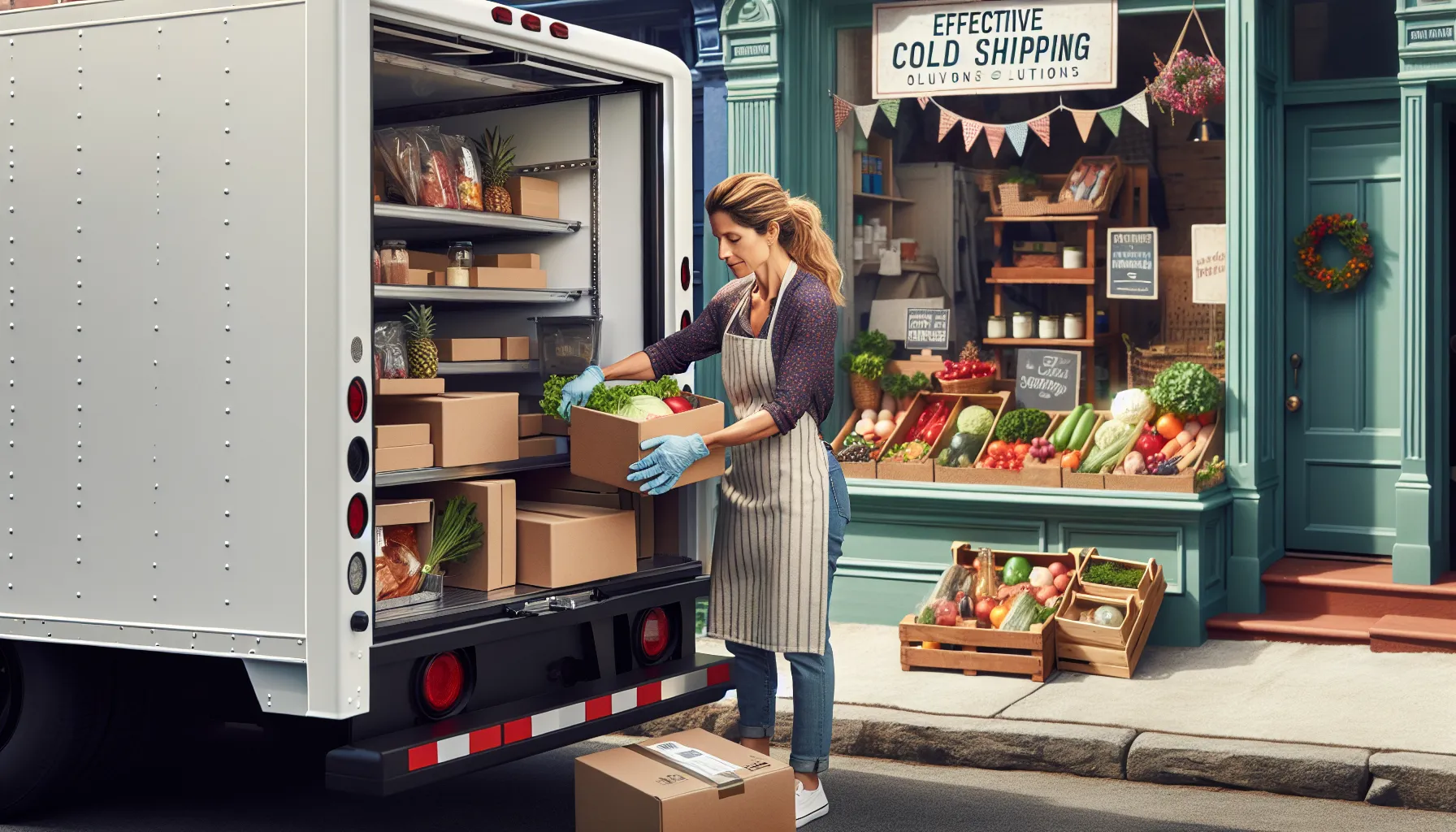Key Takeaways
- Small businesses can effectively manage cold shipping by utilizing affordable solutions such as insulated packaging, cooling agents, and temperature monitoring tools.
- Cold shipping solutions ensure product integrity, regulatory compliance, and customer satisfaction by maintaining the required temperature throughout transit.
- Reliable options like refrigerated shipping services, insulated packaging products, dry ice, and cold chain technology are essential for temperature-sensitive shipments.
- Real-time tracking and monitoring technologies help prevent spoilage, offering peace of mind and improving logistics efficiency.
- Investing in cold shipping reduces spoilage, enhances scalability, and supports market expansion by enabling businesses to ship temperature-sensitive products to distant locations.
- Overcoming challenges like high costs, limited access to services, or compliance issues requires strategic planning, partnerships, and leveraging tailored resources for small businesses.
Running a small business that requires shipping temperature-sensitive products can feel overwhelming. Whether it’s fresh produce, medical supplies, or gourmet treats, keeping items cold and intact during transit is no small feat. I know firsthand how tricky it can be to find reliable and affordable solutions that don’t compromise quality.
The good news? Cold shipping isn’t just for big corporations with massive budgets. With the right tools and strategies, small businesses can deliver their products safely while maintaining their bottom line. Let’s dive into how you can make cold shipping work for your business without breaking the bank.
What Are Cold Shipping Solutions?
Cold shipping solutions are methods and technologies designed to maintain a specific temperature range during transit. These solutions preserve the integrity of temperature-sensitive products like perishable food, pharmaceuticals, and vaccines. They combine insulated packaging, cooling agents, and monitored logistics.
Packaging includes insulated boxes, styrofoam containers, and thermal liners. Each option helps reduce temperature fluctuations and protect products from external heat. Cooling agents such as gel packs and dry ice keep shipments cold, with the choice of agent depending on the required temperature and shipping duration. Long transit times often benefit from dry ice, while short shipments might use gel packs.
Monitoring technology tracks real-time temperature and location. Tools like data loggers and GPS trackers alert businesses to potential temperature risks, allowing quick intervention before spoilage occurs.
Why Small Businesses Need Cold Shipping Solutions

Cold shipping solutions ensure that temperature-sensitive products maintain their quality during transit. For small businesses handling items like gourmet food, skincare products, or biologics, cold shipping protects their inventory from spoilage and preserves customer satisfaction.
Offering quality assurance builds trust and expands customer reach. With reliable cold shipping, businesses can cater to clients farther from their base, particularly in remote or underserved regions, without compromising product integrity.
Regulatory compliance is essential for many industries requiring cold chain solutions. For instance, pharmaceuticals and perishable goods often come with strict temperature maintenance regulations. Using cold shipping ensures adherence to these standards and avoids potential fines or legal issues.
Cost efficiency improves when product spoilage decreases. Without proper cold shipping, damaged goods can lead to financial losses and reputational harm. Cold shipping solutions help mitigate these risks, enabling more resourceful operations.
Scaling operations becomes feasible when cold shipping solutions are in place. Offering diverse product categories, such as frozen meals or probiotic drinks, allows small businesses to attract varied customer bases, support growth, and boost revenue.
Key Features To Look For In Cold Shipping Solutions

Finding the right cold shipping solution ensures temperature-sensitive products stay intact during transit. I focus on four features that make a solution effective and reliable.
Temperature Control
Effective temperature control prevents product spoilage during shipping. I ensure the solution offers precise temperature range maintenance tailored to the product’s requirements. Examples include refrigerated systems for frozen goods and ambient control for pharmaceuticals.
Packaging Options
Proper packaging safeguards products against external temperature fluctuations. I look for solutions offering insulated boxes, thermal liners, and reliable cooling agents like gel packs or dry ice. Selecting the right packaging depends on the shipment duration and product sensitivity.
Tracking and Monitoring
Tracking tools provide transparency and peace of mind during transit. I prefer solutions equipped with real-time monitoring features like data loggers, GPS trackers, or Bluetooth sensors. These technologies alert me if any temperature deviations occur, allowing immediate action.
Cost-Effectiveness
Balancing costs and quality ensures affordability for small businesses. I prioritize solutions that reduce spoilage risk, optimize packaging sizes, and offer bulk shipping discounts. This reduces operational costs while maintaining product integrity.
Top Cold Shipping Solutions For Small Businesses

Small businesses can rely on several cold shipping solutions to ensure their temperature-sensitive products arrive in excellent condition. These options range from refrigerated shipping services to advanced cold chain technology.
Refrigerated Shipping Services
Refrigerated shipping services offer controlled environments for transporting perishable items. Providers like FedEx Cold Shipping and UPS Refrigerated Delivery specialize in maintaining appropriate temperatures during transit. I recommend exploring these services for their reliability and coverage. Many providers offer temperature-controlled trucks, same-day delivery options, and specialized services for industries like healthcare and food. Choosing the right service depends on your budget, shipment size, and target delivery area.
Insulated Packaging Products
Insulated packaging helps businesses protect shipments from temperature fluctuations during delivery. Options like foam coolers, insulated pouches, and thermal liners suit a wide range of products. I often see businesses use insulated mailers for small food items and medical products due to their compact design and effectiveness. Pairing insulated packaging with cooling agents, such as gel packs, creates an optimal environment for preserving product quality. Selecting reusable options, when possible, reduces long-term packaging costs.
Dry Ice Supplies and Guidelines
Dry ice provides highly effective cooling for shipments that need to stay below freezing. Suppliers like Airgas and Continental Carbonic offer dry ice in pellets or blocks, making it easy to pack for various shipping needs. I advise careful handling since dry ice can cause burns or release harmful CO2 gas in poorly ventilated areas. Maps of dry ice usage guidelines set by courier services like UPS and USPS help manage compliance. It’s ideal for products such as frozen foods and certain pharmaceuticals.
Cold Chain Shipping Technology
Advanced cold chain technology ensures precise temperature control and monitoring throughout transit. Tools like temperature data loggers and GPS-equipped trackers allow me to keep an eye on shipments, ensuring they remain within specified parameters. Real-time alerts provide immediate updates if temperatures fluctuate, letting businesses take quick action to prevent spoilage. Platforms like TempAlert and Controlant integrate these tools into cloud-based systems for easy management and reporting. Small businesses with consistent cold shipping needs can benefit greatly from these investments.
Benefits Of Using Cold Shipping Solutions
Cold shipping solutions offer multiple advantages for small businesses handling temperature-sensitive products. These solutions help ensure product quality and integrity from shipment to delivery. Businesses using these methods can avoid spoilage, which reduces waste and protects inventory.
Enhanced customer satisfaction is another benefit. Delivering fresh or intact products builds trust and increases repeat business. For example, when shipping perishable food or pharmaceuticals, customers expect their orders to arrive in prime condition.
Regulatory compliance becomes manageable with cold shipping tools. Industries like healthcare and food often require strict adherence to temperature guidelines. Meeting these standards helps avoid penalties and ensures business operations run smoothly.
Cost savings are achieved when spoilage and product loss decrease. While investing in cold shipping may seem significant initially, businesses save money long-term by maintaining consistent product quality and minimizing damages. It also supports market expansion by enabling businesses to reach farther regions without compromising shipping standards.
Additionally, cold shipping solutions simplify logistics. Real-time tracking and monitoring tools provide valuable insights into shipment temperature and location. This improves planning and accountability, ensuring smooth transit for sensitive products. As a result, operations grow more efficient, benefiting both businesses and their customers.
Challenges And How To Overcome Them
High Shipping Costs
Maintaining cold environments during transit often increases shipping costs. For small businesses, this can strain budgets. I recommend using cost-effective packaging like insulated liners with gel packs and negotiating bulk shipping rates with carriers. Leveraging regional shipping providers also reduces costs for localized deliveries.
Limited Access To Cold Chain Logistics
Many small businesses struggle to access reliable cold chain services. Researching service providers that cater to small volumes, like localized refrigerated transport companies, helps bridge this gap. I also explore partnerships with third-party logistics companies (3PLs) offering tailored cold shipping solutions.
Packaging Inefficiencies
Improper packaging increases spoilage risks. Testing different combinations of materials, such as integrating thermal liners with phase change materials, optimizes shipment protection. Keeping packaging lightweight further lowers shipping costs while maintaining efficiency.
Temperature Fluctuations
Inconsistent temperature control during transit leads to product spoilage. I use real-time monitoring devices like temperature sensors and data loggers to ensure shipments stay within required ranges. If issues occur, I address them promptly with notifications from these tools.
Regulatory Compliance
Small businesses often find it difficult to navigate compliance rules for temperature-sensitive products. Researching industry-specific regulations provides clarity. Partnering with certified cold chain providers helps ensure adherence to guidelines without additional strain.
Limited Expertise In Cold Shipping
Lack of knowledge makes managing shipments challenging. I focus on training staff in packaging and monitoring technologies. Attending webinars and leveraging online guides tailored to small businesses expand understanding of cold shipping logistics.
Conclusion
Cold shipping doesn’t have to be overwhelming or out of reach for small businesses. With the right tools, strategies, and a bit of planning, you can confidently ship temperature-sensitive products while maintaining quality and meeting customer expectations.
By focusing on effective packaging, reliable monitoring, and cost-efficient solutions, you’ll not only protect your products but also build trust with your customers and open doors to new opportunities. Cold shipping is an investment in your business’s growth and reputation, and it’s absolutely worth exploring.
Frequently Asked Questions
What is cold shipping?
Cold shipping refers to transporting temperature-sensitive products using methods and technologies that maintain a specific temperature range. This ensures that items like fresh produce, pharmaceuticals, and vaccines remain intact and safe during transit.
Why do small businesses need cold shipping solutions?
Small businesses need cold shipping solutions to preserve product quality, prevent spoilage, enhance customer satisfaction, and comply with industry regulations. It allows them to scale operations, reduce losses, and support growth in competitive markets.
What are the most common cold shipping methods?
Common methods include using refrigerated shipping services, insulated packaging (like thermal liners or foam coolers), cooling agents (such as dry ice or gel packs), and advanced monitoring tools for real-time temperature tracking.
How can small businesses reduce the costs of cold shipping?
Small businesses can lower costs by using cost-effective packaging, negotiating bulk shipping rates, working with reliable local providers, and opting for long-lasting cooling agents. Investing in reusable materials can also reduce long-term expenses.
What is the role of technology in cold shipping?
Technology, like data loggers and GPS trackers, helps monitor temperature and location during transit in real-time. These tools prevent spoilage, ensure regulatory compliance, and enhance operational efficiency.
What packaging options are best for cold shipping?
The best packaging depends on the product’s needs. Insulated boxes, thermal liners, foam coolers, gel packs, and dry ice are common. Durable, high-quality materials are critical to maintaining temperature stability.
Are cold shipping solutions accessible to small businesses?
Yes, cold shipping is accessible to small businesses. Affordable providers, cost-effective packaging options, and advancements in cold chain technology make it easier for small businesses to implement cold shipping strategies successfully.
How do cold shipping solutions improve product quality?
Cold shipping maintains optimal temperatures during transit, preventing spoilage and preserving the integrity of temperature-sensitive items. This ensures fresh or effective delivery to customers, building trust and satisfaction.
How can small businesses address temperature fluctuations during transit?
Small businesses can address temperature fluctuations by using high-quality insulated packaging, reliable cooling agents, and real-time monitoring devices. Testing materials and routes can also minimize risks.
What are the benefits of cold shipping for small businesses?
The benefits include enhanced product quality, reduced spoilage, regulatory compliance, increased customer satisfaction, long-term cost savings, and the ability to expand market reach with diverse product offerings.

